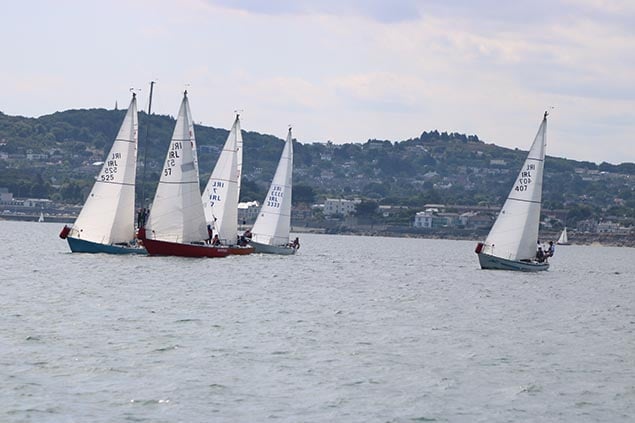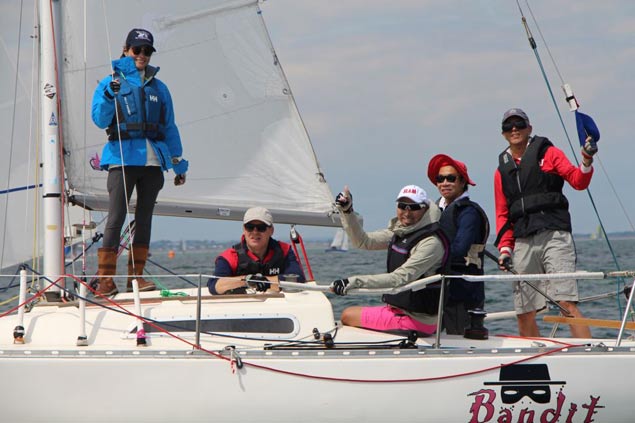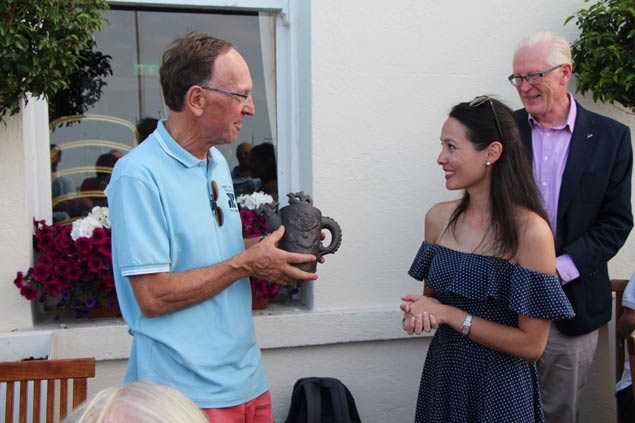The sixth Interport Ruffian 23 challenge between Ireland and Hong Kong took place in Dun Laoghaire at the weekend. The 12-strong team of Ruffian sailors from RHKYC arrived in Dun Laoghaire on Thursday evening and joined the Irish sailors for post-DBSC racing drinks in the RStGYC.
The 1st Interport Ruffian challenge took place in 1993 in Hong Kong with the Hong Kong Ruffian sailors coming to Dun Laoghaire the following year. The challenge was revitalised in 2009 when an Irish contingent travelled to Hong Kong. Since then the event has occurred every 3 years with the Irish team travelling to Hong Kong again in 2015, and the Hong Kong team coming to Dun Laoghaire in 2012 and again this year.
The event officially kicked off with a practice race on Friday afternoon followed by a welcome reception in the DMYC. The group was treated to Michael Cutliffe’s presentation on the history of the Ruffian 23, followed by a taste of traditional music featuring a tin whistle and Northumbrian pipes among other instruments. Some of the Hong Kong team got a lesson in playing the pipes.
"The first Interport Ruffian challenge took place in 1993 in Hong Kong with the Hong Kong Ruffian sailors coming to Dun Laoghaire the following year"
The Interport challenge commenced on Saturday with 3 Hong Kong teams allocated 3 Ruffians to compete in 2 fleet races in the RStGYC regatta. Hong Kong’s Peter Leung finished 3rd overall in Bandit (owned by Brian Cullen, Ciara Brown, and Ann Kirwan). The Irish team of Ripples (Frank Bradley, DMYC), Icicle (Colm Murray, NYC), and Ruff Rider (Willie Finnie, DMYC) won both matches.
The RStGYC kindly awarded prizes to each of the 3 Hong Kong teams. Following the regatta prize giving the group had dinner in the NYC’s JB Room on Saturday night.
Sunday saw another sunny day with the sea breeze kicking in around 11.30. Race officer Larry Power got racing off to a prompt start once the breeze settled, with the objective of holding a 6 race series with the teams swapping boats after 3 races.
The Hong Kong team (Peter Leung sailing Diane II, Olly Cully sailing Ripples and Cathy Lam sailing Ruffles) made a great comeback to win the first 2 races so the score was level at that point. However, the Irish team (Ann Kirwan sailing Bandit, David Meeke sailing Ripples and Al Mitton sailing Alias) fought back to win race 3. Following the swapping of boats, the Irish team went on to win the next 2 races. RO Larry Power called it a day as the wind was dying and the 6th race had no bearing on the result, the Irish team winning the challenge with 5 wins to Hong Kong’s 2.
 A race start in the Sunday team racing
A race start in the Sunday team racing
 The Hong Team of Christina, Brian, Jason, Julian and Peter were third in the RStGYC regatta
The Hong Team of Christina, Brian, Jason, Julian and Peter were third in the RStGYC regatta
 Carmel Winkelmann presenting the Winkelmann trophy to the Irish team
Carmel Winkelmann presenting the Winkelmann trophy to the Irish team
The Irish team commissioned artist Brian O’Loughlin to produce a gift made from a piece of ancient bog oak (5,000-7,000 years old) to present to the visitors. The Hong Kong team presented the DMYC, RStGYC, and NYC each with a Hong Kong teapot, traditionally filled with rum and coke by a race winner to share with fellow competitors.
 Willie Finnie presenting Christina Cully with the bog oak piece, and below Christina presenting Willie with the Hong Kong teapot
Willie Finnie presenting Christina Cully with the bog oak piece, and below Christina presenting Willie with the Hong Kong teapot

 Both teams on the platform of the NYC following the event prize giving
Both teams on the platform of the NYC following the event prize giving
The event was officially over apart from one further social event on Monday, July 9th when 10 of the Hong Kong group plus 12 Irish headed over to Howth on the St. Bridget ferry and had a lovely lunch hosted by the Hong Kong sailors in glorious sunshine on Howth Yacht Club’s upper deck. The Irish team looks forward to the return visit to Hong Kong in 2021.
 The Hong Kong and Irish Ruffian sailors enjoying lunch in Howth Yacht Club
The Hong Kong and Irish Ruffian sailors enjoying lunch in Howth Yacht Club

























